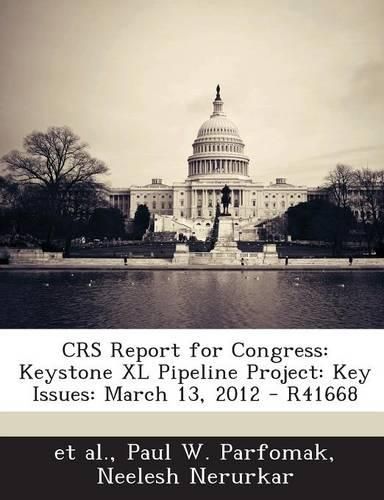Readings Newsletter
Become a Readings Member to make your shopping experience even easier.
Sign in or sign up for free!
You’re not far away from qualifying for FREE standard shipping within Australia
You’ve qualified for FREE standard shipping within Australia
The cart is loading…






In 2008, Canadian pipeline company TransCanada filed an application with the U.S. Department of State to build the Keystone XL pipeline, which would transport crude oil from the oil sands region of Alberta, Canada, to refineries on the U.S. Gulf Coast. Keystone XL would ultimately have the capacity to transport 830,000 barrels per day, delivering crude oil to the market hub at Cushing, OK, and further to points in Texas. TransCanada plans to build a pipeline spur so that oil from the Bakken formation in Montana and North Dakota can also be carried on Keystone XL. As a facility connecting the United States with a foreign country, the pipeline requires a Presidential Permit from the State Department. In evaluating such a permit application, after consultation with other relevant federal agencies and public input, the department must determine whether a proposal is in the “national interest.” This determination considers the project’s potential effects on the environment, economy, energy security, foreign policy, and other factors. Pursuant to the National Environmental Policy Act, the State Department considered potential environmental impacts of the proposed Keystone XL project in a final Environmental Impact Statement (EIS) issued on August 26, 2011. A wide range of public …
$9.00 standard shipping within Australia
FREE standard shipping within Australia for orders over $100.00
Express & International shipping calculated at checkout
In 2008, Canadian pipeline company TransCanada filed an application with the U.S. Department of State to build the Keystone XL pipeline, which would transport crude oil from the oil sands region of Alberta, Canada, to refineries on the U.S. Gulf Coast. Keystone XL would ultimately have the capacity to transport 830,000 barrels per day, delivering crude oil to the market hub at Cushing, OK, and further to points in Texas. TransCanada plans to build a pipeline spur so that oil from the Bakken formation in Montana and North Dakota can also be carried on Keystone XL. As a facility connecting the United States with a foreign country, the pipeline requires a Presidential Permit from the State Department. In evaluating such a permit application, after consultation with other relevant federal agencies and public input, the department must determine whether a proposal is in the “national interest.” This determination considers the project’s potential effects on the environment, economy, energy security, foreign policy, and other factors. Pursuant to the National Environmental Policy Act, the State Department considered potential environmental impacts of the proposed Keystone XL project in a final Environmental Impact Statement (EIS) issued on August 26, 2011. A wide range of public …